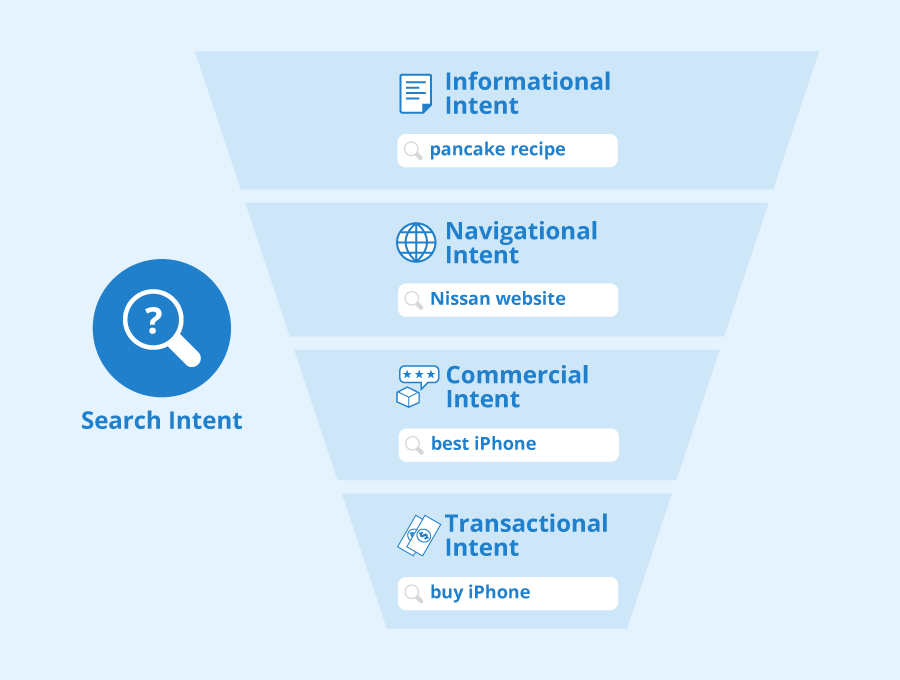Pulse of Information
Stay updated with the latest news and insights.
Search Intent: The Hidden Key to Your SEO Success
Unlock the secret to skyrocketing your SEO! Discover how understanding search intent can transform your strategy and boost rankings.
Understanding Search Intent: Why It Matters for Effective SEO
Understanding search intent is crucial in the realm of SEO, as it dictates how users interact with search engines. Search intent can be classified into four main categories: informational, navigational, transactional, and commercial investigation. Recognizing these categories allows you to create content that aligns with the specific needs of your audience. For instance, if a user searches for 'how to bake a cake,' their intent is clearly informational, and providing a detailed recipe along with baking tips can satisfy that query. On the other hand, a user searching for 'buy cake mix' has transactional intent, indicating they are ready to make a purchase. Thus, tailoring your content to match these intents enhances user experience and improves your site's visibility on search engines.
Incorporating search intent into your SEO strategy not only boosts your chances of ranking higher but also ensures that you attract the right kind of traffic. When search engines like Google understand that your content matches the user's intent, it increases the likelihood of your site being featured prominently in search results. To achieve this, it's essential to conduct thorough keyword research and analyze search behavior. Utilize tools to identify commonly searched phrases and their associated intents. By optimizing your content with relevant keywords and structuring it in a way that addresses users' questions or needs, you not only improve your SEO efforts but also create a more engaging and informative experience for your audience.

How to Align Your Content with Search Intent for Higher Rankings
To effectively align your content with search intent, it is crucial to understand the different types of intent that users have when they enter a query. The three primary categories include informational, navigational, and transactional. Informational intent seeks to provide users with answers to specific questions, while navigational intent aims to help users find a particular website or page. Lastly, transactional intent indicates that a user is ready to purchase a product or service. By analyzing your target keywords and identifying the intent behind them, you can tailor your content to meet the specific needs of your audience, which can significantly enhance your rankings in search engine results.
Once you have identified the search intent, the next step is to create content that comprehensively addresses the queries associated with that intent. Start by organizing your content in a logical structure, using headers and subheaders to break down complex topics into digestible sections. Incorporate relevant keywords naturally throughout your content, particularly in titles, headings, and within the first 100 words of the article. Additionally, consider including visual elements such as images, infographics, or videos, as these can enhance user engagement and retention. In doing so, you not only align your content with search intent but also provide a valuable experience for your audience that encourages them to stay longer on your page—further boosting your SEO efforts.
Top Strategies for Identifying and Utilizing Search Intent in Your SEO Campaigns
Identifying search intent is crucial for optimizing your SEO campaigns effectively. Start by categorizing search intent into four main types: navigational, informational, transactional, and commercial investigation. Each of these types reflects the user's underlying motivation when they input a query into a search engine. For instance, a user searching for 'best running shoes' may have commercial investigation intent, while someone searching 'how to tie running shoes' likely has informational intent. Understanding these nuances will enable you to tailor your content to fulfill specific user needs, thus enhancing your visibility on search engine results pages (SERPs).
Once you've identified the search intent, the next step is to align your content strategy accordingly. Focus on creating high-quality, relevant content that directly addresses the search intent associated with your target keywords. Consider employing techniques such as keyword clustering to group related keywords according to intent, which can streamline content creation. Additionally, utilize tools like Google Search Console and keyword research tools to analyze user queries and refine your SEO approach. By continuously monitoring search intent shifts and adjusting your strategies, you can maintain a competitive edge in your SEO campaigns.